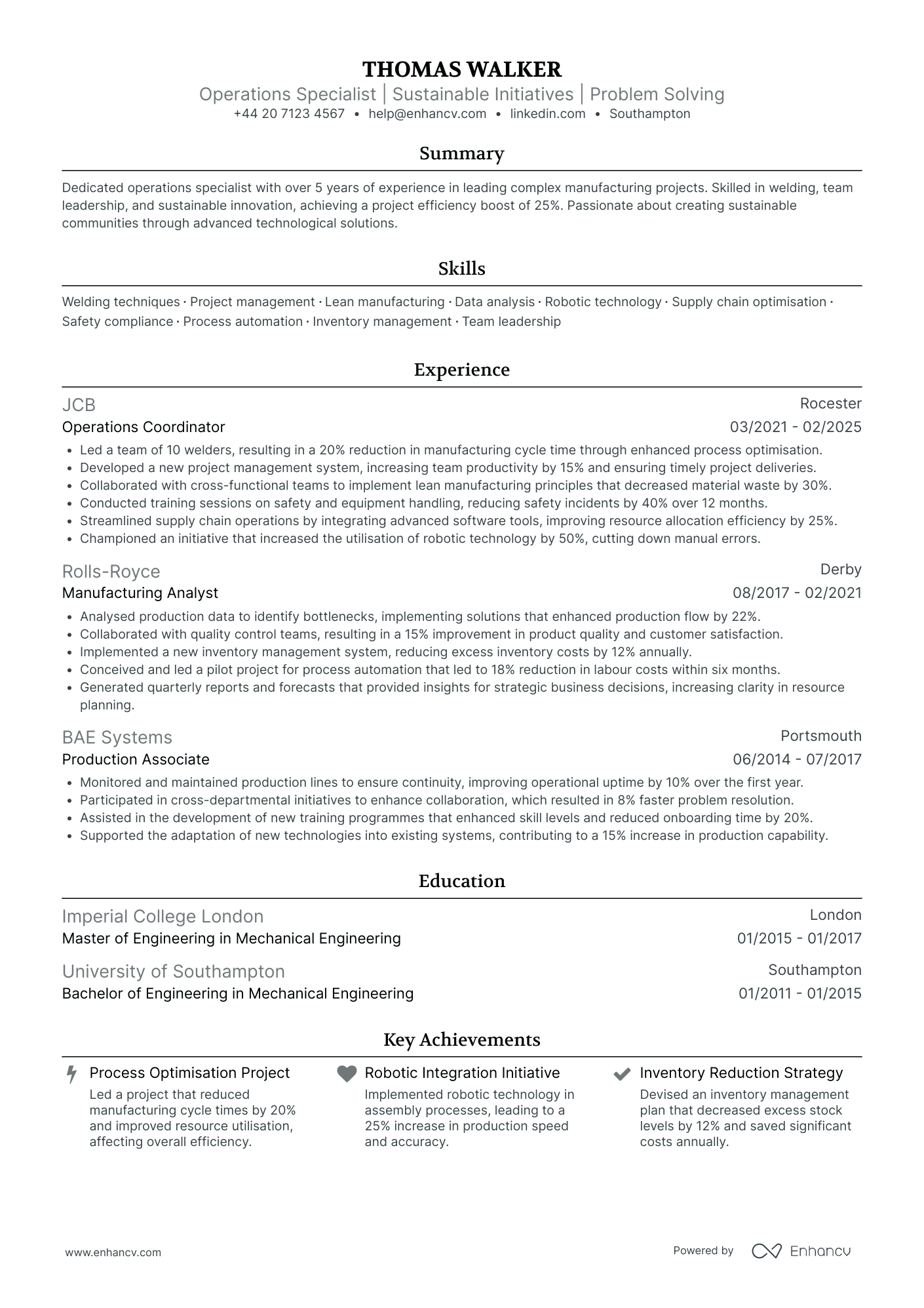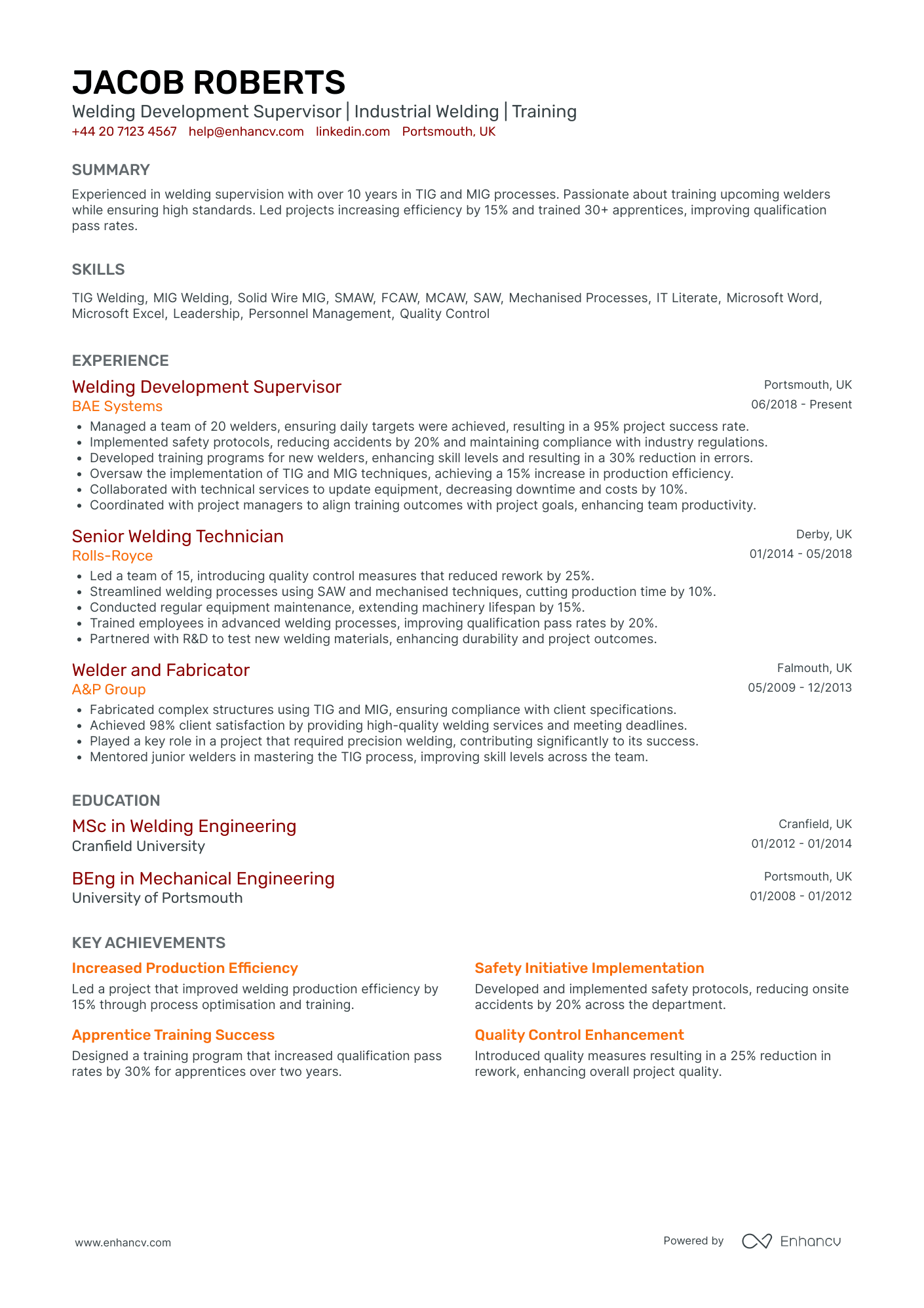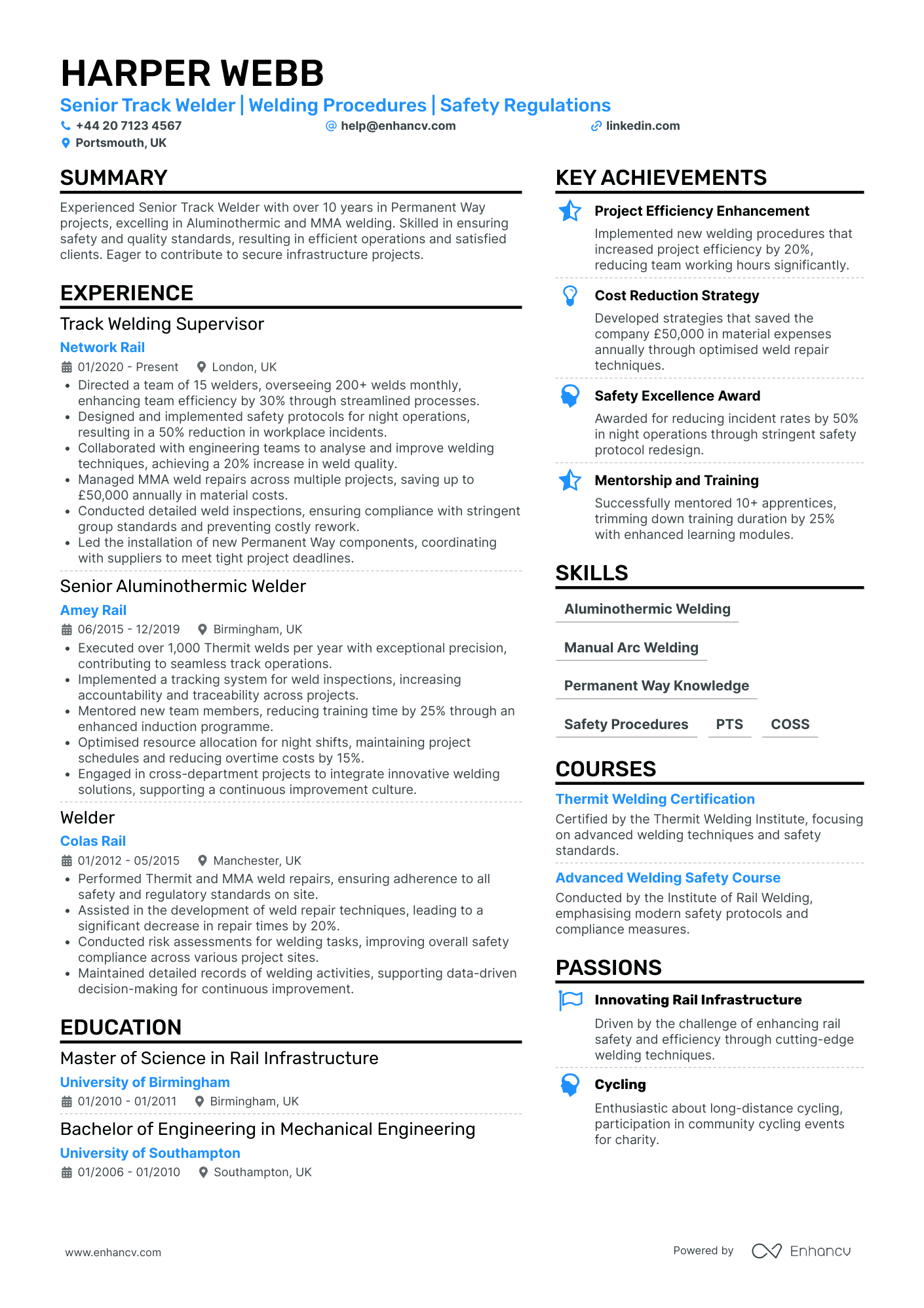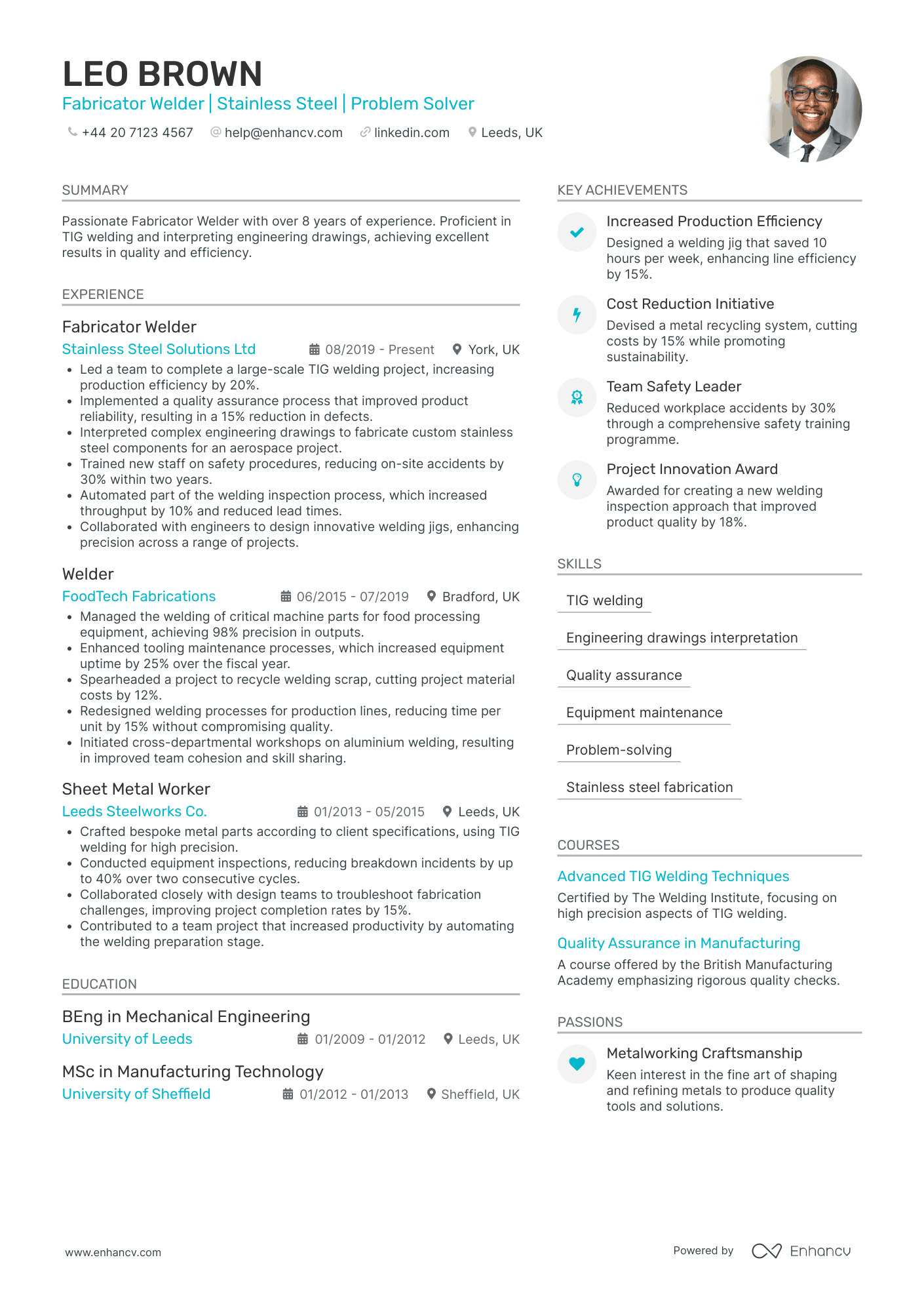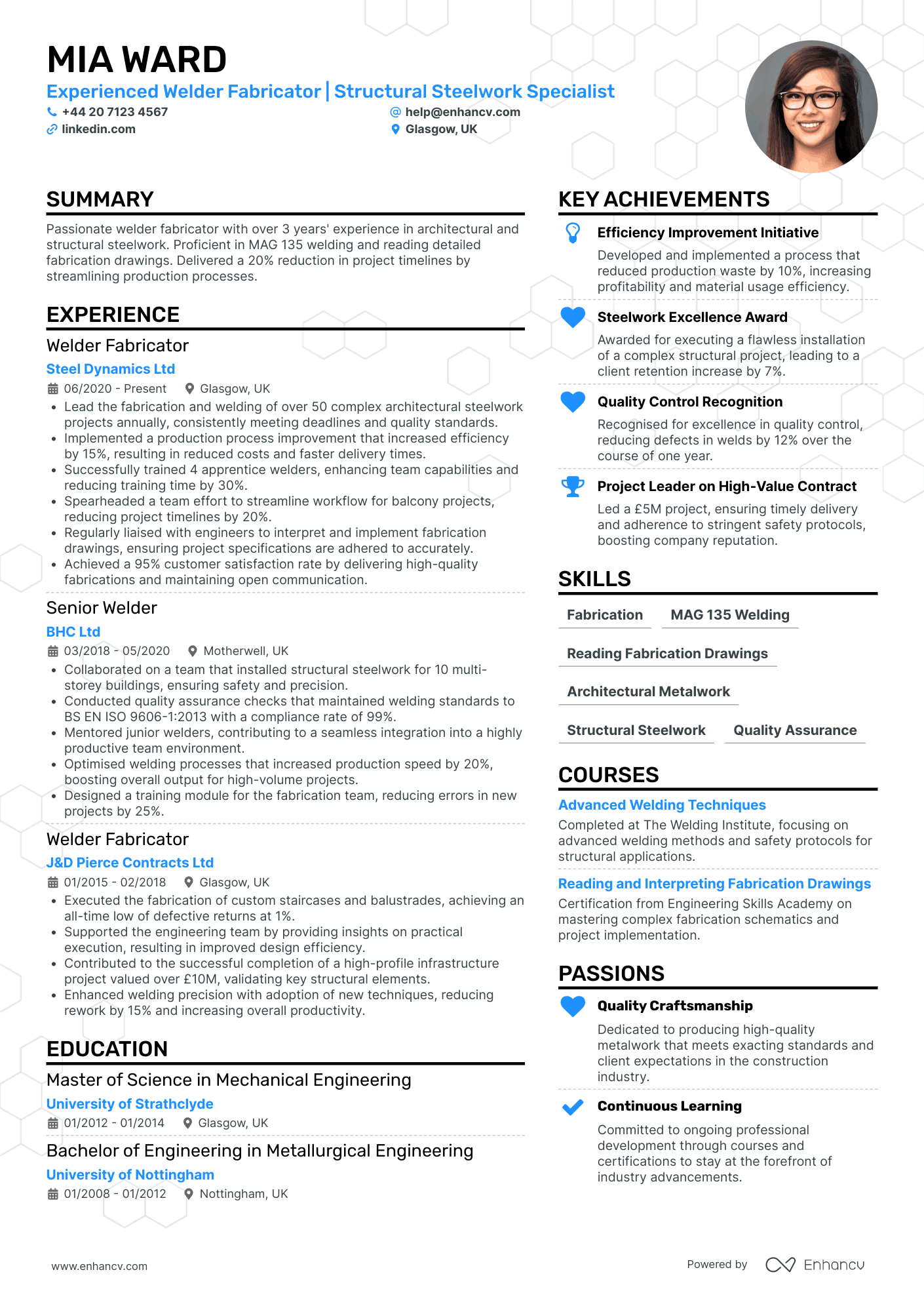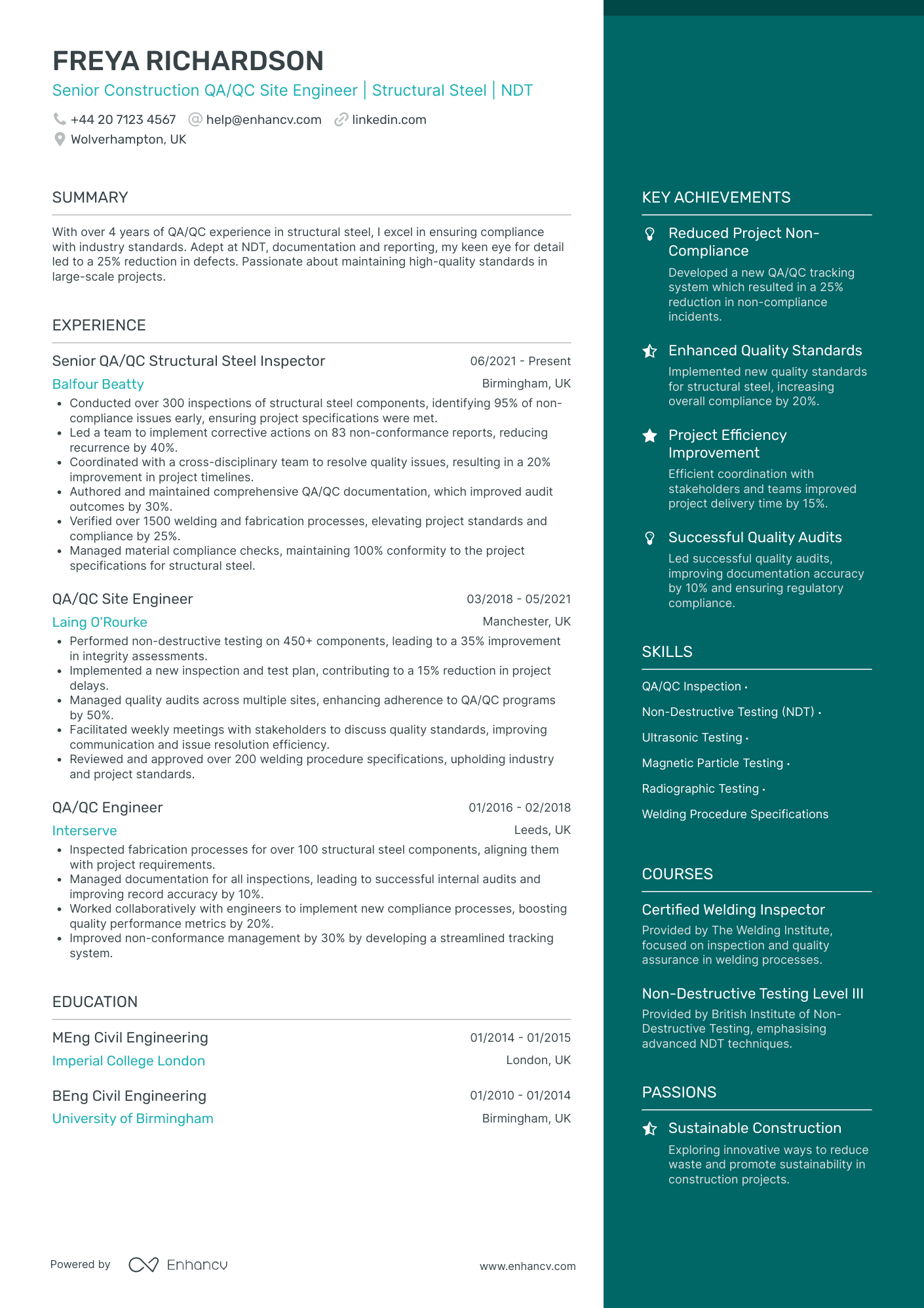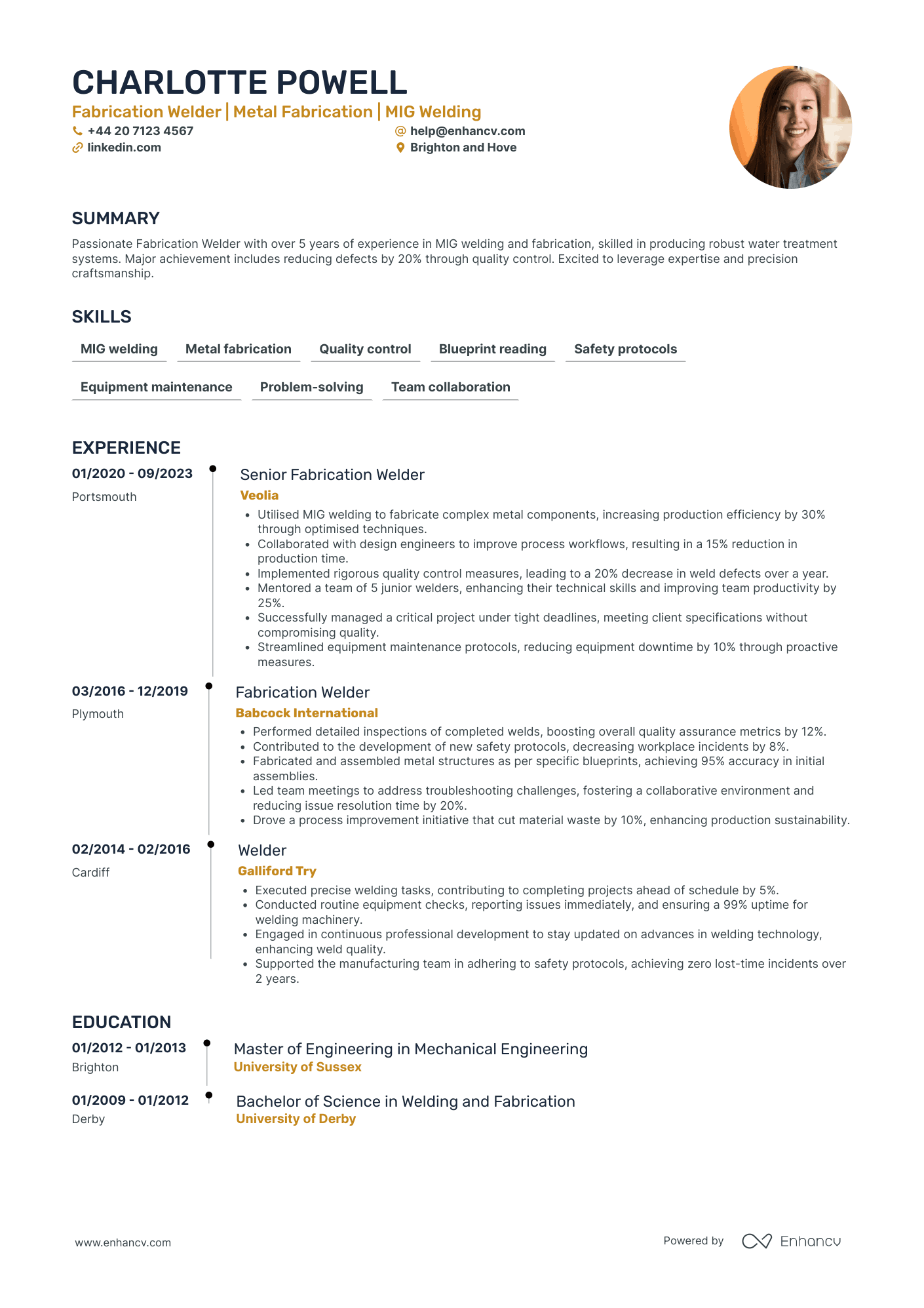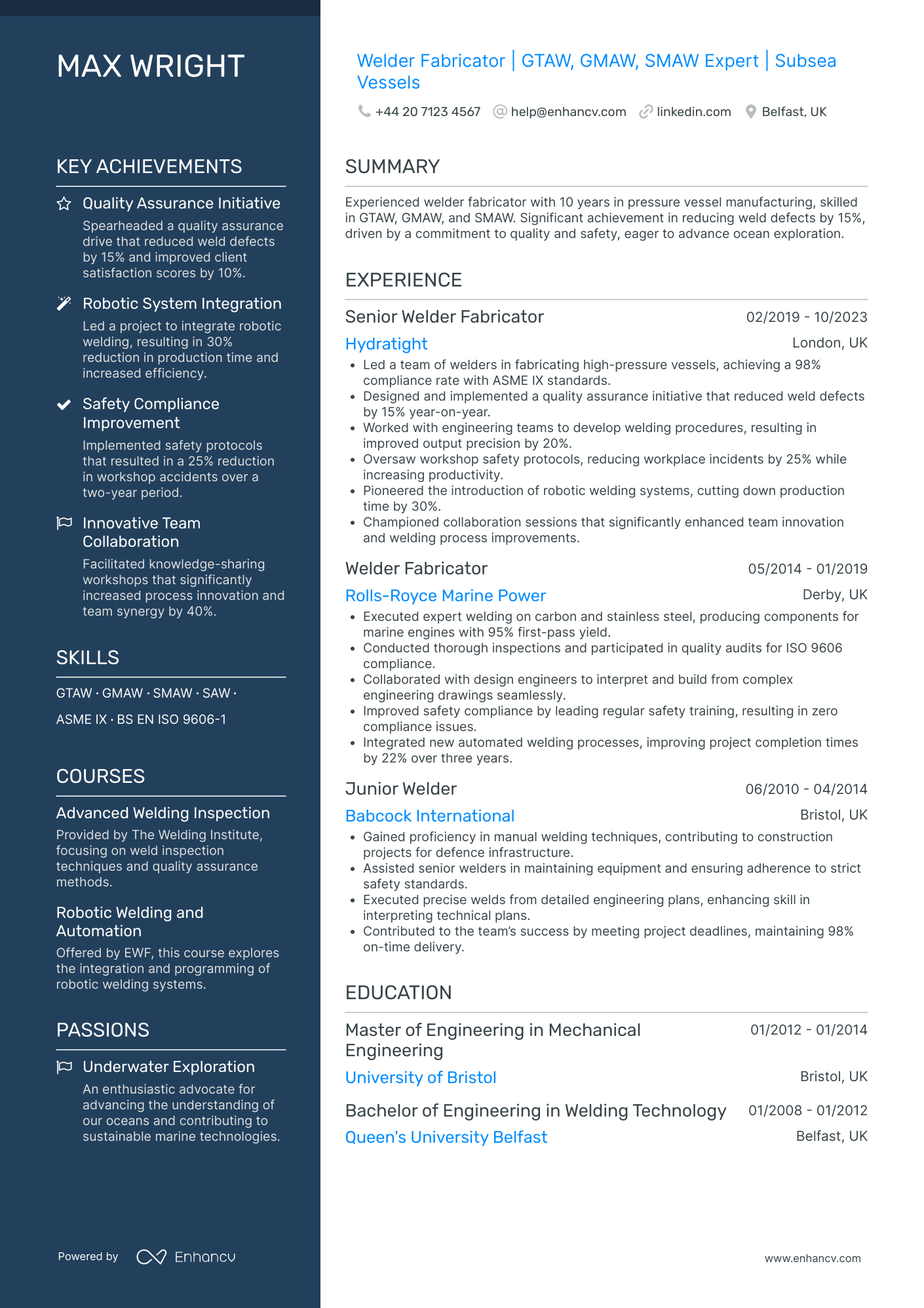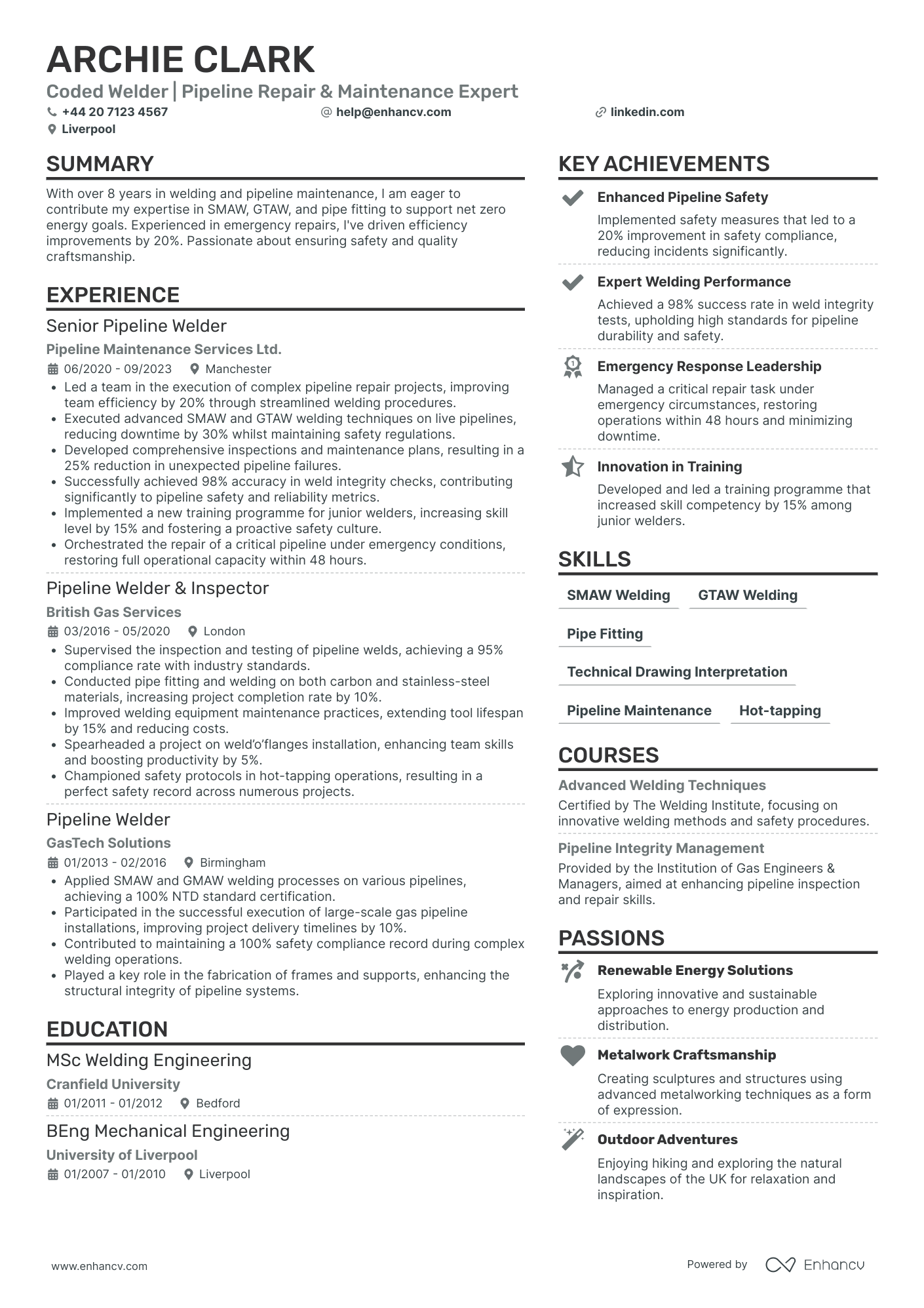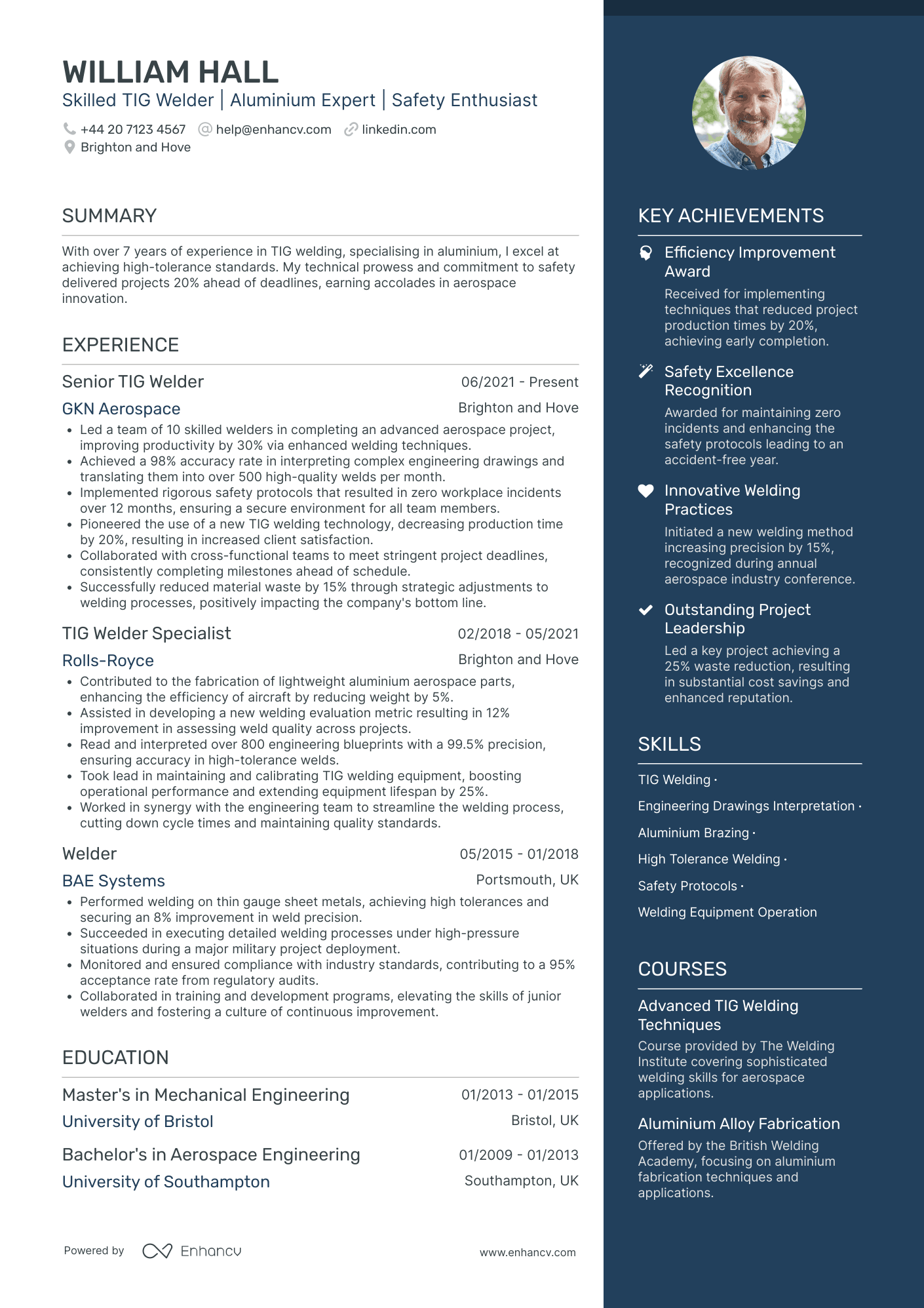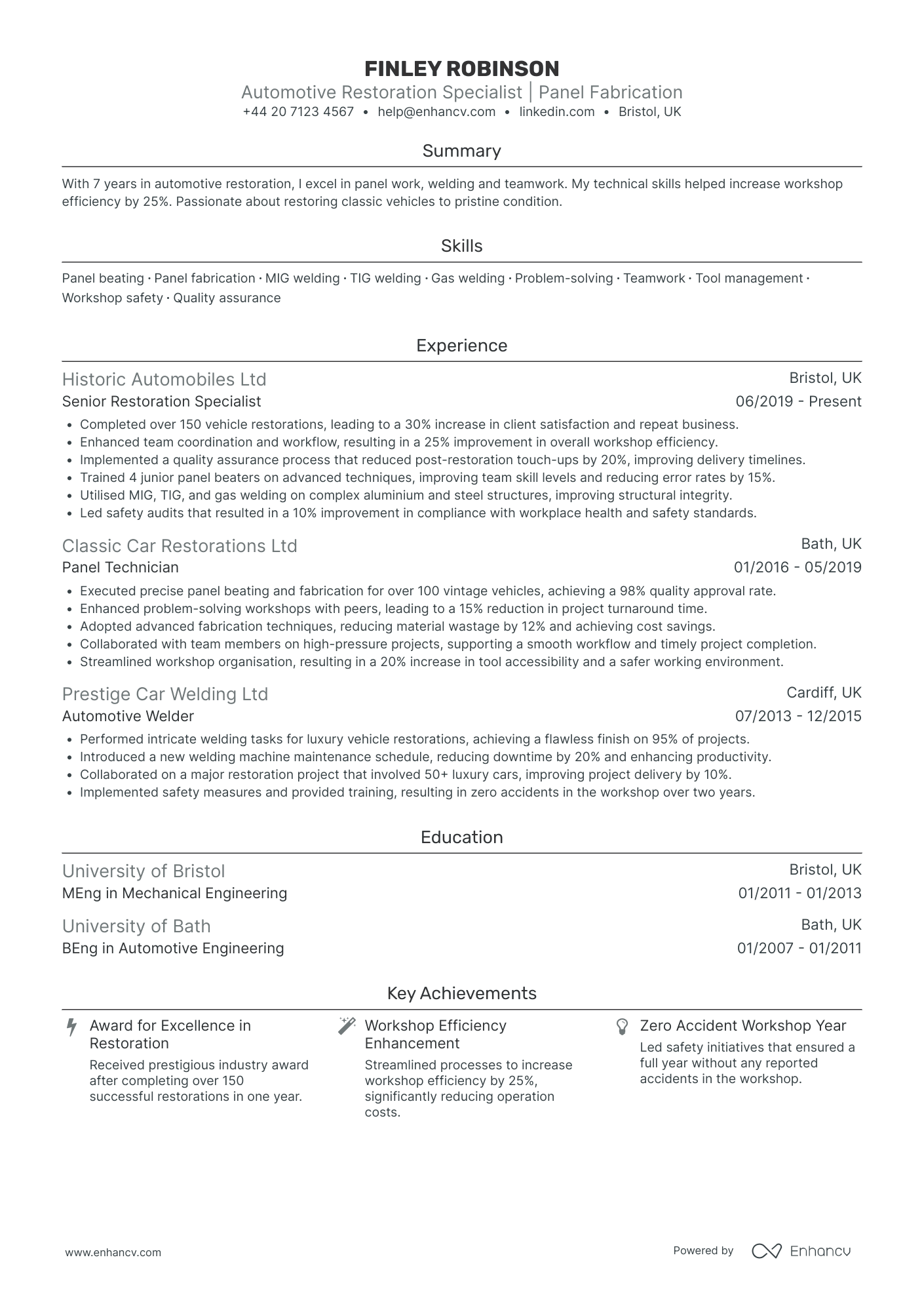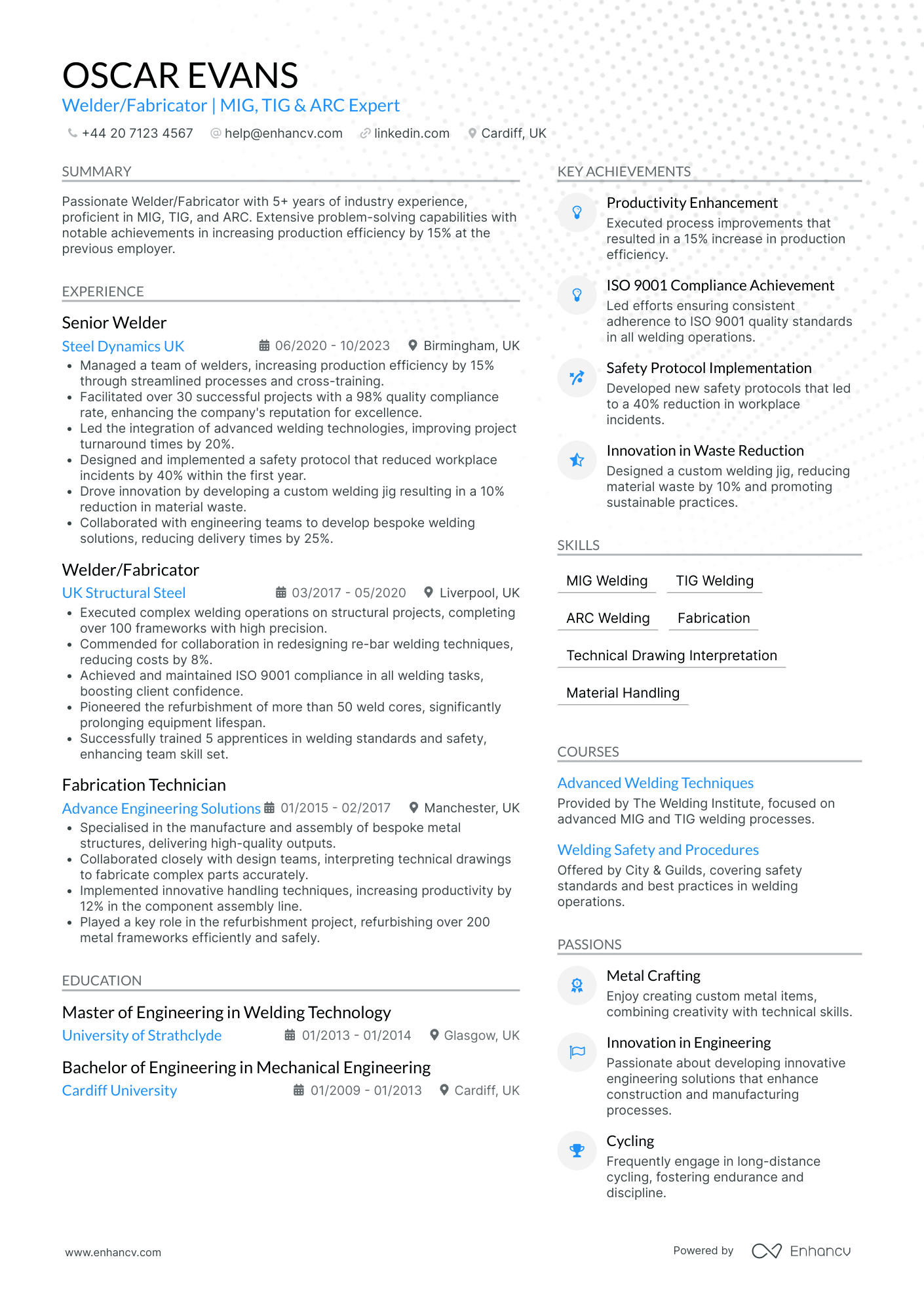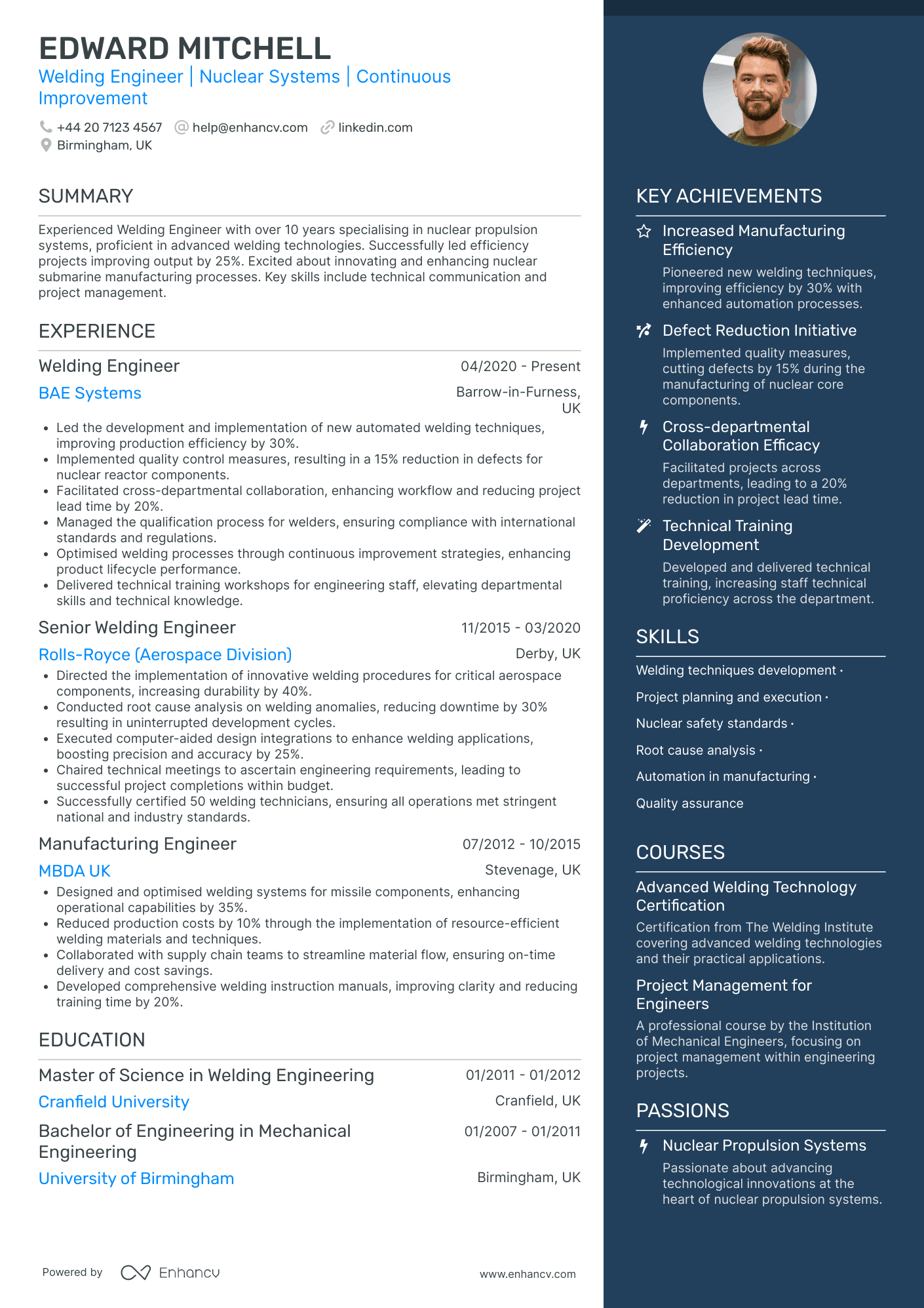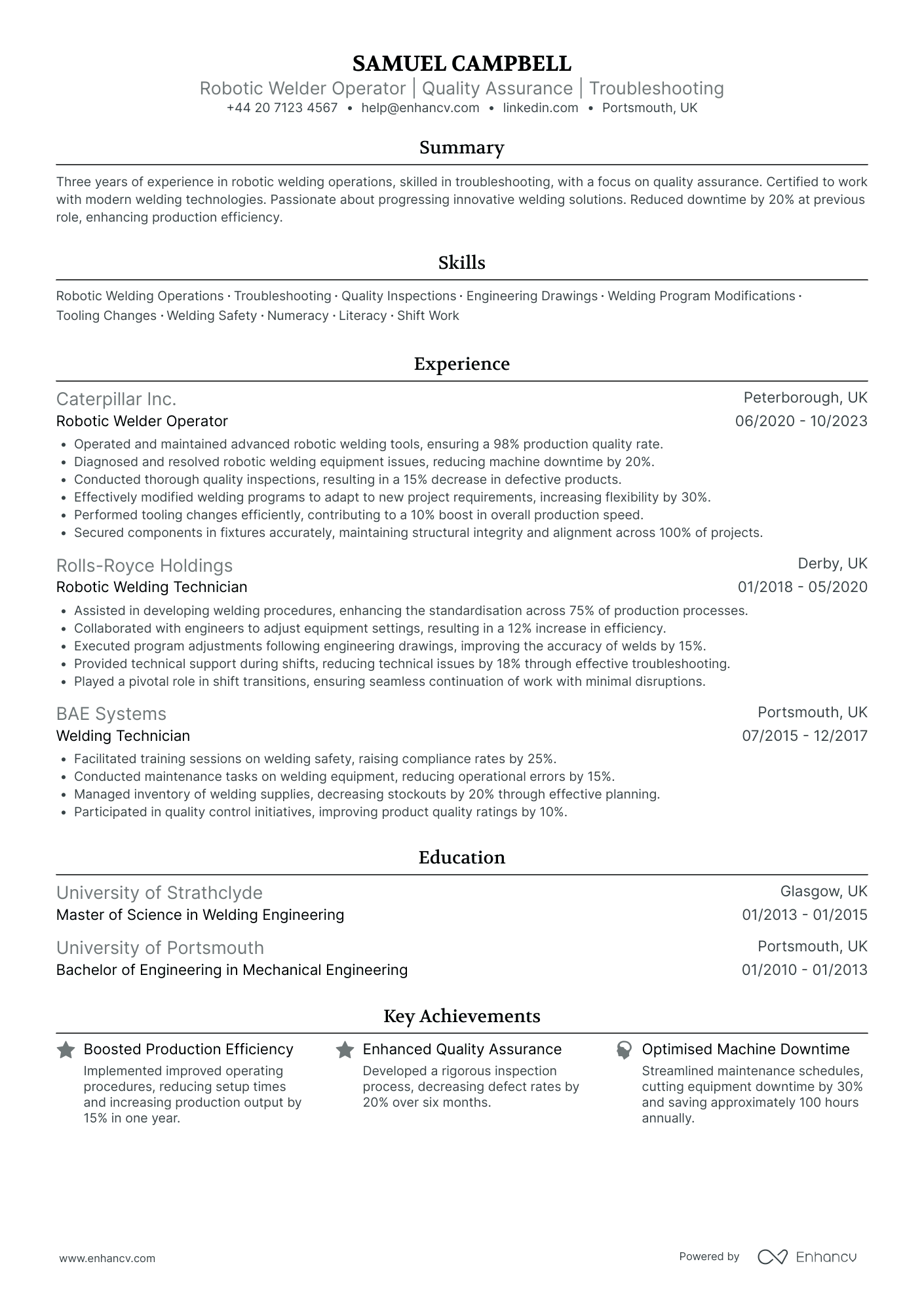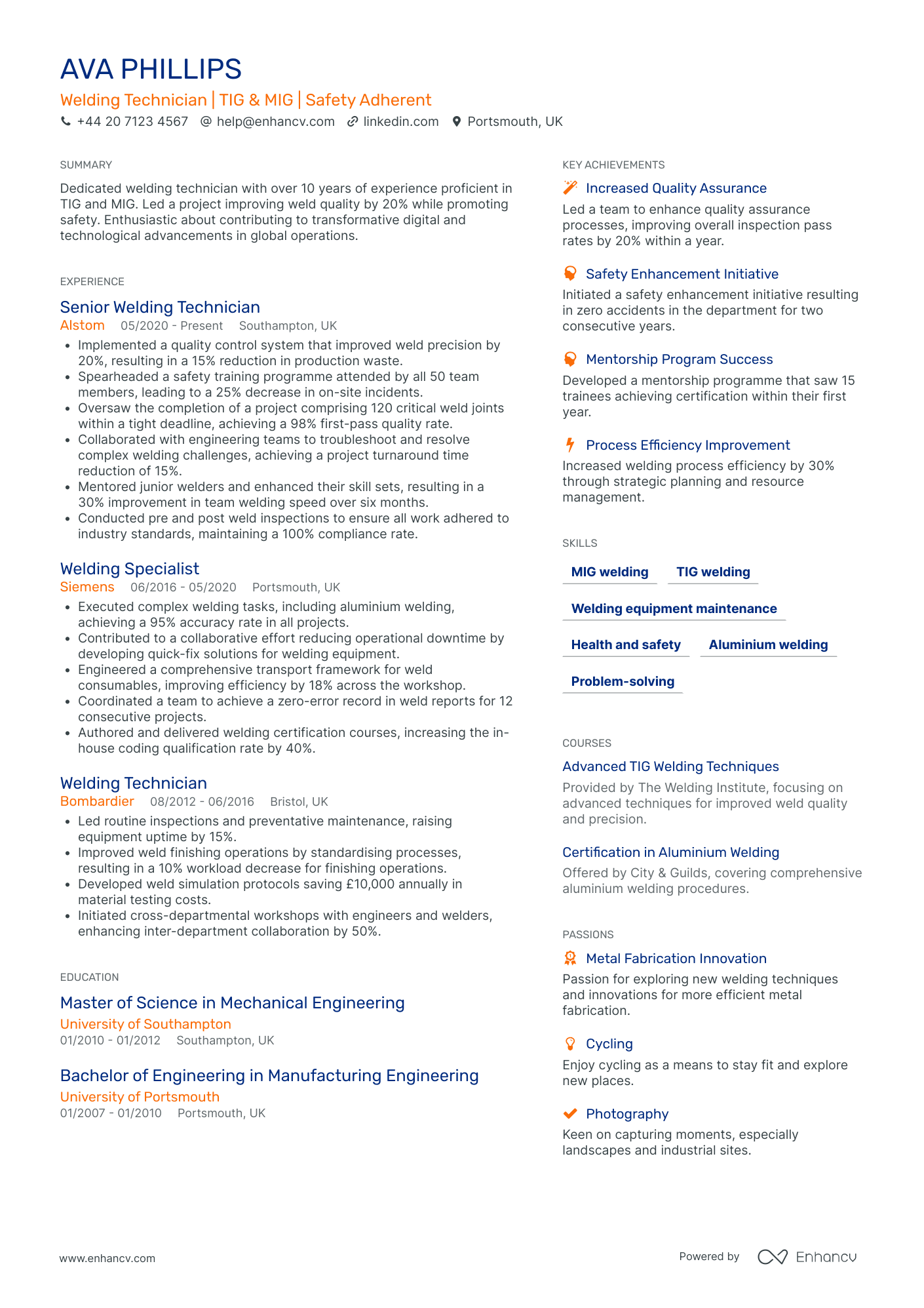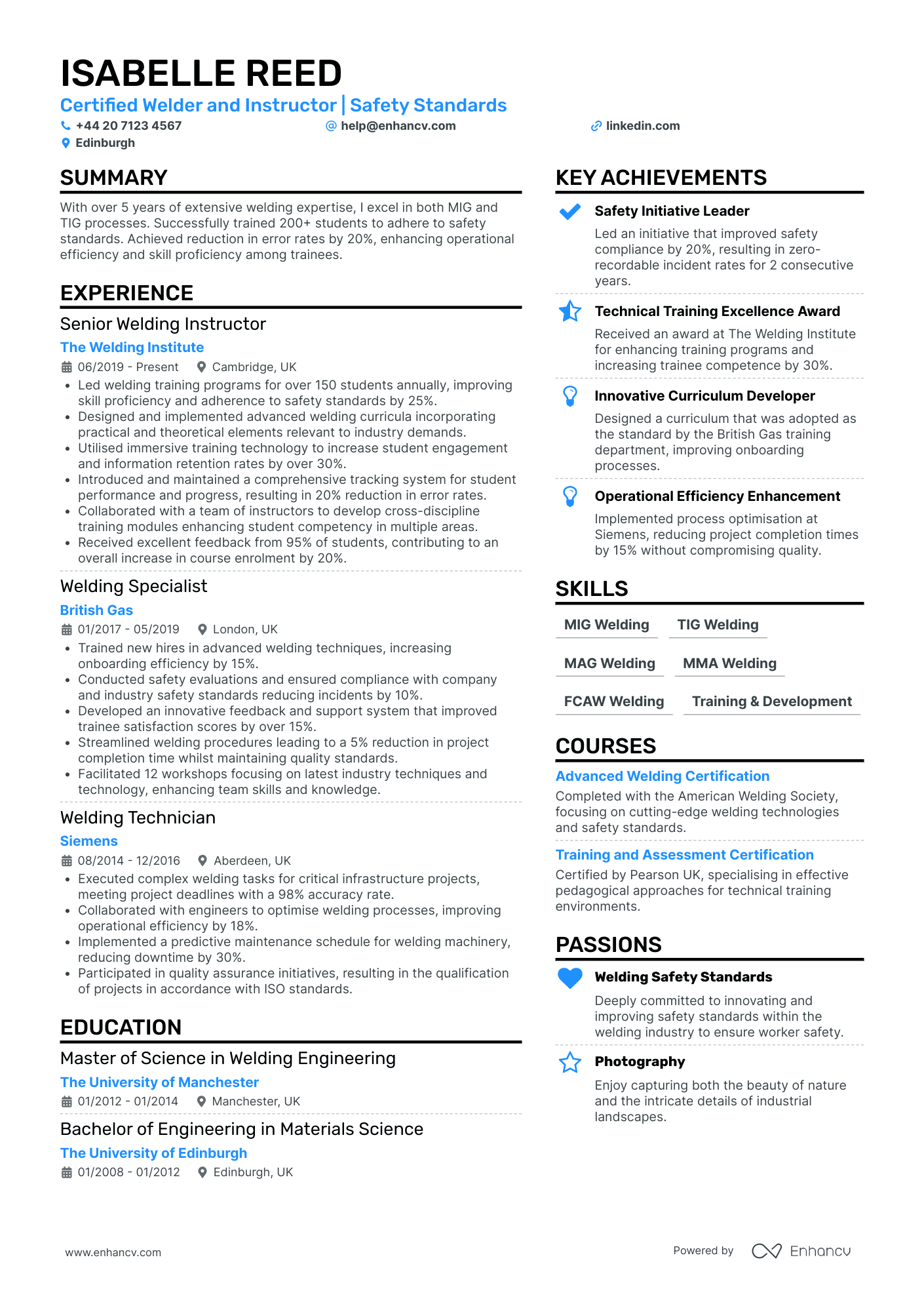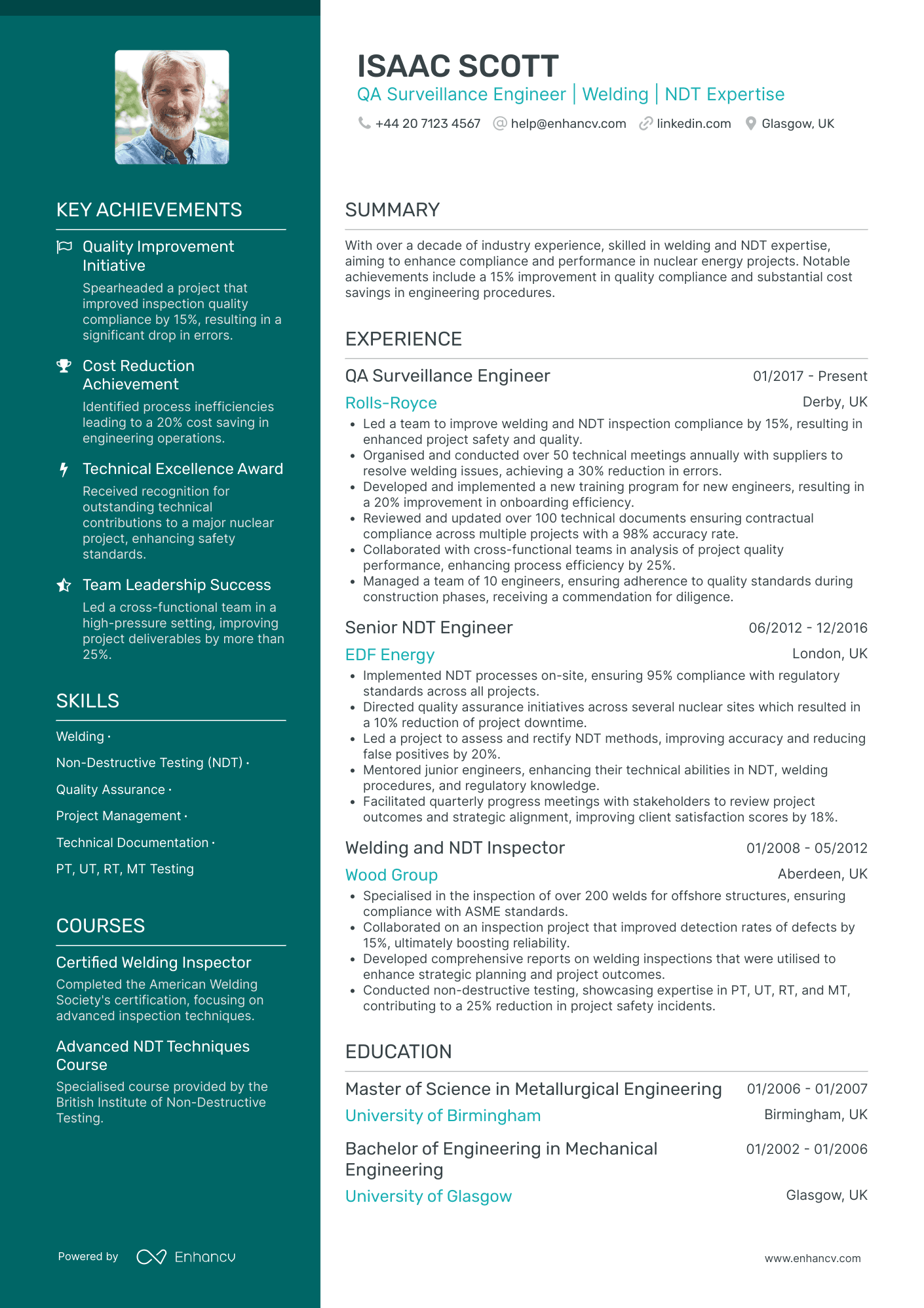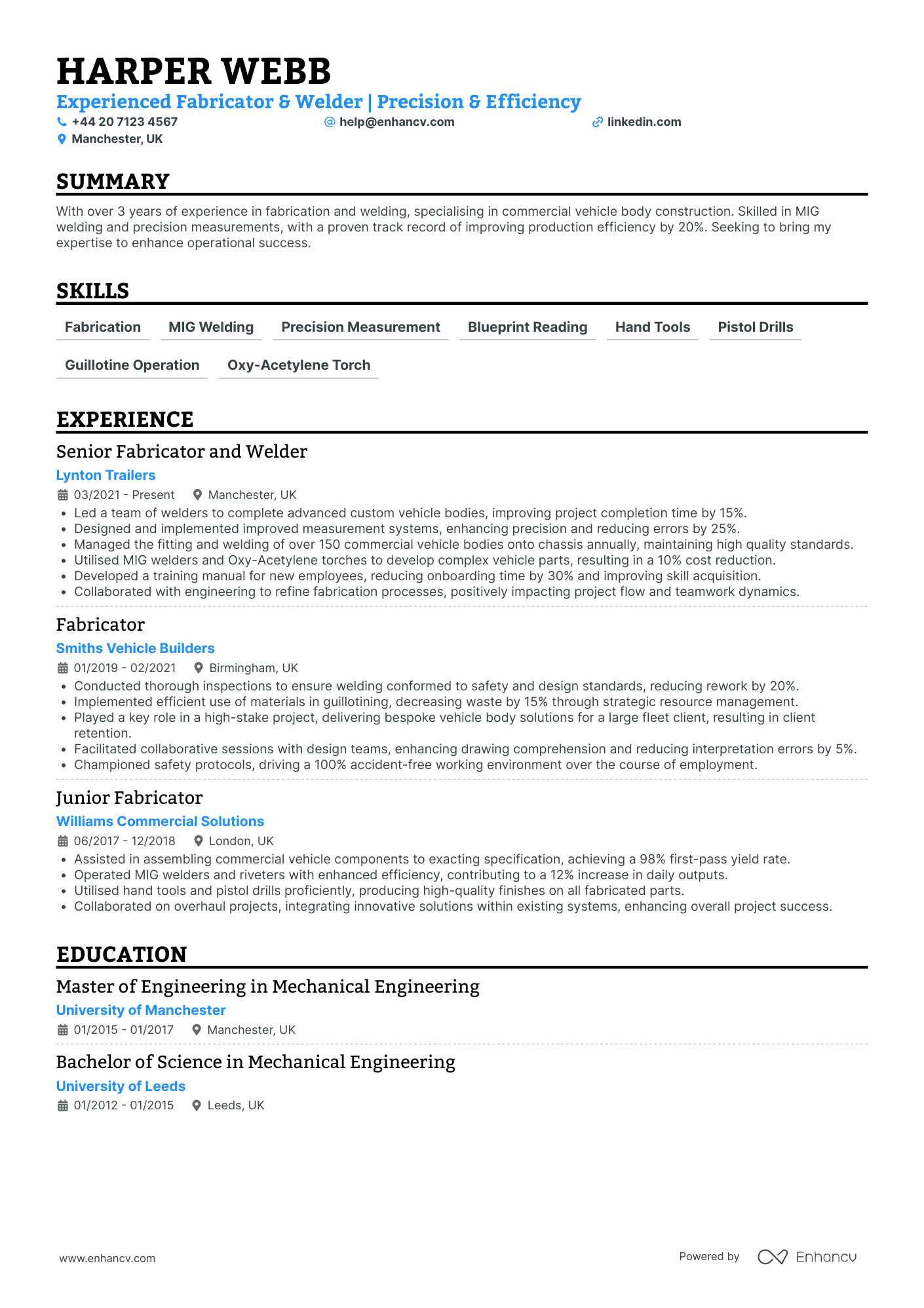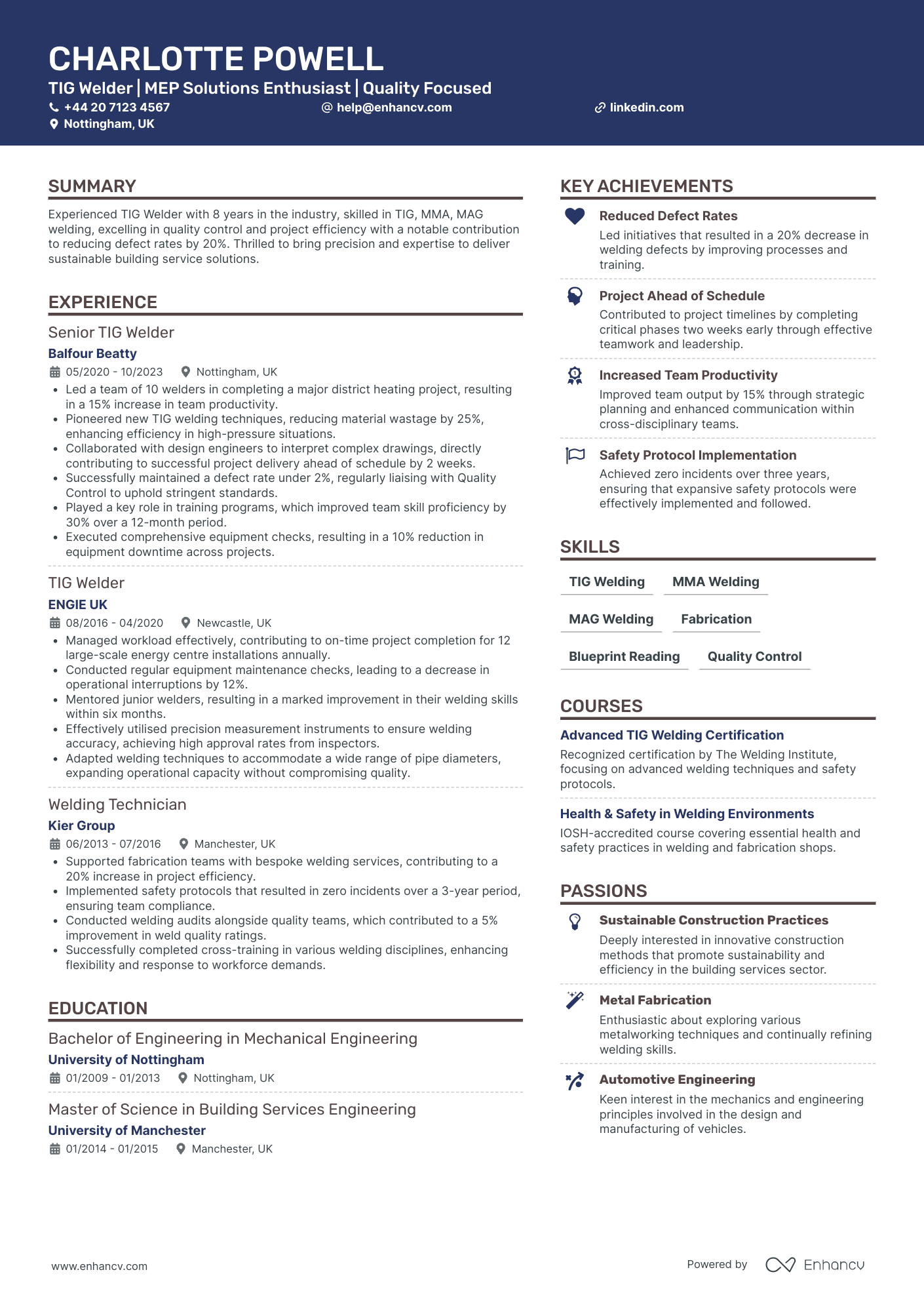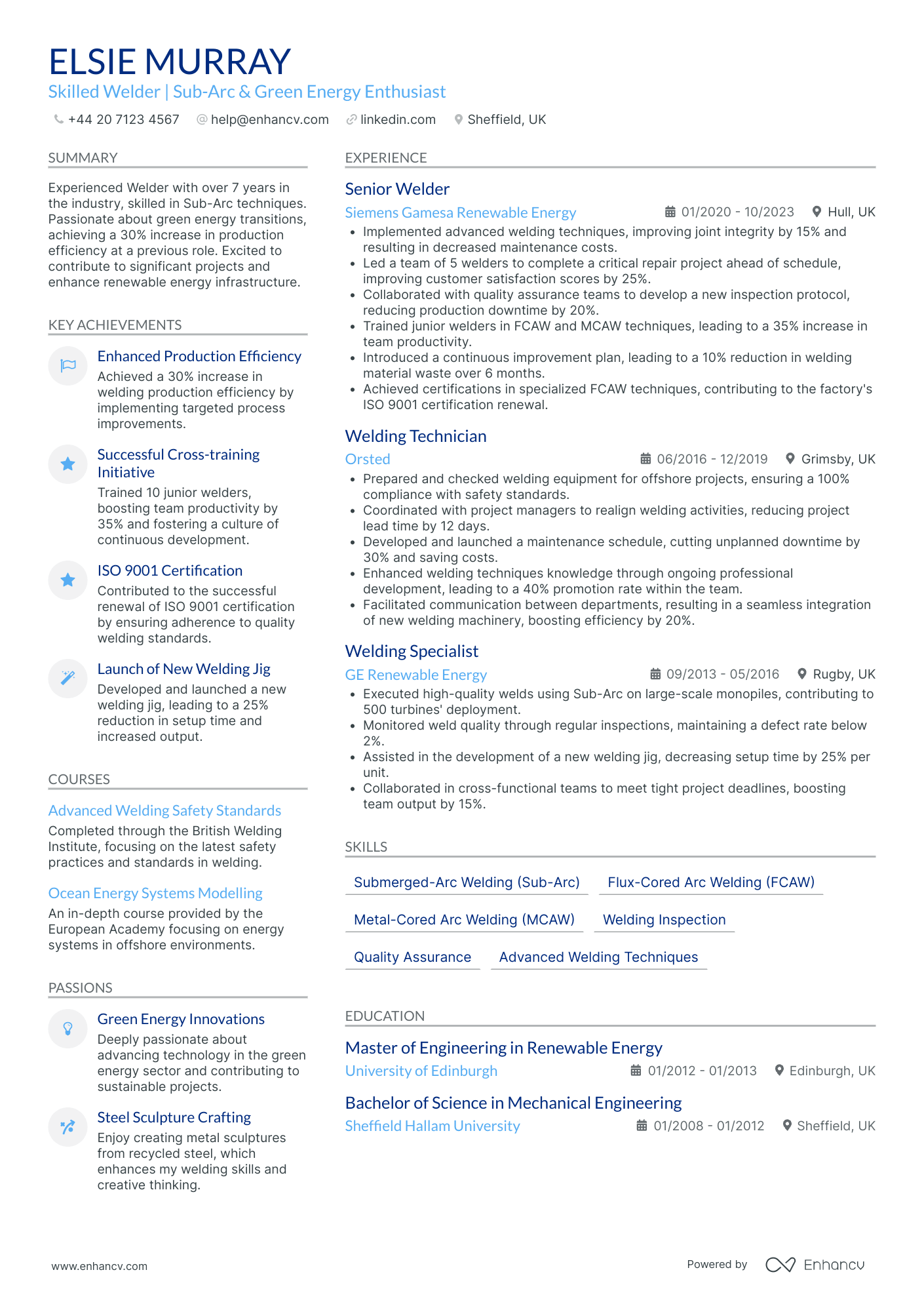One of the specific CV challenges you may face as a welder is succinctly showcasing the diversity of your welding techniques to potential employers. Our guide offers targeted advice on structuring your experience and using industry-relevant terminology that will highlight your skill set effectively.
- Applying best practices from real-world examples to ensure your profile always meets recruiters' expectations;
- What to include in your work experience section, apart from your past roles and responsibilities?
- Why are both hard and soft skills important for your application?
- How do you need to format your CV to pass the Applicant Tracker Software (ATS) assessment?
If you're writing your CV for a niche welder role, make sure to get some inspiration from professionals:
Resume examples for welder
By Experience
Welder Apprentice
- Comprehensive career progression - The CV details a clear upward growth trajectory, beginning as a Production Associate and advancing to an Operations Coordinator. This progression showcases the candidate's expanding responsibilities and expertise in operations within top industry companies like BAE Systems, Rolls-Royce, and JCB, reflecting consistent career growth and industry trust.
- Robust expertise in sustainable practices - Notably, the CV emphasizes the candidate's commitment to sustainability with projects and initiatives targeted at reducing waste and improving resource efficiency. It highlights achievements such as a 30% reduction in material waste and projects related to sustainable manufacturing, underscoring their dedication to eco-friendly practices within the industrial sector.
- Adaptability and technological innovation - The CV highlights the candidate's adaptability and proficiency with cutting-edge technologies, evident from successfully integrating robotic technology which improved production speed and accuracy. This shows their ability to embrace technological advancements and apply them effectively across various operational processes to enhance efficiency.
Welder Supervisor
- Structured and Clear Presentation - The CV is well-organized, employing a clear layout that delineates roles, responsibilities, and achievements articulately. Each section is precisely labeled, which aids in easy navigation, highlighting the candidate's career progression and academic accomplishments without overwhelming the reader.
- Impressive Career Growth - Jacob Roberts has demonstrated remarkable career progression, moving from a Welder and Fabricator to a Welding Development Supervisor. This journey within notable companies like BAE Systems and Rolls-Royce showcases his ability to take on increased responsibilities and excel, indicating solid professional development and industry recognition.
- Application of Industry-specific Skills - The CV illustrates a profound depth of technical knowledge in welding, underlining his expertise with processes such as TIG, MIG, and SAW. The inclusion of mechanized techniques and process optimization efforts underscores a robust understanding of the industry's technical requirements, offering potential employers confidence in his specialized abilities.
Senior Welder
- Structured and Comprehensive Content Presentation - The CV is well-organized, presenting detailed information in a clear and concise manner. Each section flows logically, allowing potential employers to quickly grasp the candidate's qualifications and experiences relevant to the welding profession.
- Career Progression and Leadership Development - Harper Webb's career trajectory demonstrates significant growth, moving from a Welder position to a Senior Track Welder and finally to a Track Welding Supervisor. This progression showcases their leadership capabilities and commitment to advancing within the rail industry.
- Technical Expertise in Welding and Safety Regulations - The CV highlights unique industry-specific skills such as Aluminothermic and MMA welding, underpinning their technical depth. Additionally, it showcases their proficiency in devising safety protocols and performing detailed weld inspections, emphasizing their knowledge of ensuring safety and compliance.
Welding Foreman
- Effective use of career progress to show depth - Leo's career trajectory is well-articulated, showcasing growth from a Sheet Metal Worker to a Fabricator Welder. This upward movement demonstrates not only his skill acquisition but his increasing responsibility and expertise within the welding and fabrication industry, underlined by significant contributions at each stage.
- Rich technical depth specific to industry practices - The CV includes advanced welding techniques and engineering drawing interpretation, which are critical in stainless steel fabrication. This technical depth shows a detailed understanding of both practical execution and theoretical knowledge, essential for high-precision tasks in aerospace and food processing sectors.
- Emphasis on leadership and team improvement - Highlighted achievements, such as leading a team to enhance production efficiency and implementing quality assurance processes, underscore Leo's leadership capabilities. These experiences not only show his ability to improve operational efficiency but also his role in fostering a safe, cohesive, and innovative work environment.
By Role
Structural Steel Welder
- Structured and Clear Presentation - The CV excels in clarity and organization, offering a logical flow from personal information to professional experience, skills, education, and achievements. Each section is clearly defined and provides concise yet comprehensive information, making it easy for readers to navigate and quickly grasp Mia's qualifications and career achievements.
- Significant Career Progression - Mia's career trajectory is marked by consistent growth, as evidenced by her advancement from a Welder Fabricator to a Senior Welder, and eventually leading complex projects and teams. This upward movement indicates professional development and a deepening of skills and responsibilities within the structural steelwork industry, emphasizing her leadership capabilities and technical acumen.
- Industry-Specific Expertise - The CV highlights unique technical competencies such as proficiency in MAG 135 welding, adherence to BS EN ISO 9606-1:2013 standards, and the ability to interpret fabrication drawings. These specialized skills underline Mia's expertise in her field and her capacity to contribute effectively to significant architectural and steelwork projects.
Certified Welding Inspector
- Focused Career Development - Freya Richardson’s CV illustrates a clear progression in her career as a Construction QA/QC Site Engineer, with over 4 years of specialized experience in structural steel and NDT. Her movement from Interserve as a QA/QC Engineer to a senior role at Balfour Beatty showcases her robust career growth and continuous enhancement of skills and responsibilities.
- Technical Specialized Proficiency - The CV stands out with its strong emphasis on industry-specific skills such as non-destructive testing (NDT) and quality auditing. Listing detailed methodologies like ultrasonic, magnetic particle, and radiographic testing demonstrates Richardson’s technical depth, crucial for roles demanding high precision in structural engineering and QA/QC processes.
- Strong Leadership and Effective Communication - A significant aspect of Richardson’s profile is highlighted through her leadership capabilities and communication skills. She has managed teams to implement corrective actions and effectively coordinated with cross-disciplinary groups, proving her capacity to lead projects to success and enhance quality standards, which is critical in engineering environments.
Industrial Maintenance Welder
- Effective structure and clarity in presentation - The CV is well-organized, starting with an informative summary that establishes the candidate’s primary skills in fabrication welding, followed by clearly outlined sections on experience, education, skills, and achievements. Each section is concise, emphasizing key points without unnecessary elaboration, making it easy for potential employers to quickly assess the candidate's qualifications.
- Dynamic career progression and enhancement - Charlotte Powell's career trajectory showcases significant professional growth from a Welder to a Senior Fabrication Welder, with increasing responsibilities and a focus on leadership and process optimization. Her promotions are marked by achievements in process improvement, team leadership, and defect reduction, underlining her adaptability and ability to thrive in changing environments.
- Technical prowess and specialization in industry techniques - This CV stands out with its emphasis on specialized skills in MIG welding, metal fabrication, and quality control. Details about specific methodologies, like process workflows improvement and equipment maintenance, show a deep technical understanding. Additional certifications, such as the NDT Level II Certification, highlight Charlotte's commitment to staying updated with industry standards.
Underwater Welder
- Structured Career Growth - Max Wright's CV effectively outlines a clear and logical career progression, showcasing his journey from a Junior Welder at Babcock International to a Senior Welder Fabricator at Hydratight. Each role highlights increasing levels of responsibility and expertise, emphasizing his growth in the welding industry and his advancement within top companies.
- Focus on Technical Proficiency and Innovation - The CV uniquely highlights Max's proficiency in various welding techniques like GTAW, GMAW, and SMAW, showcasing a depth of technical knowledge that is crucial for his role in subsea vessel fabrication. His involvement in pioneering robotic welding systems and automated processes demonstrates a commitment to innovation and efficiency in manufacturing.
- Leadership and Safety-Driven Achievements - Max's leadership skills are underscored by his achievements in implementing safety protocols and quality assurance initiatives. The CV details his impact in reducing workplace incidents by 25% and weld defects by 15%, which not only improves operational safety but also enhances productivity and satisfaction in high-stakes engineering environments.
Pipeline Welder
- Impeccable Content Organization - This CV stands out due to its clear and concise structure, making it easy for potential employers to quickly grasp the candidate’s qualifications. Each section is well-labeled and effectively segmented, which showcases Archie's career progression and accomplishments without overwhelming the reader with excessive detail.
- Notable Career Growth - Archie Clark exhibits a strong career trajectory, advancing from a Pipeline Welder to a Senior Pipeline Welder, underscoring a pattern of professional growth and leadership development. This progression highlights his expanding expertise and responsibility within the industry, particularly within pipeline repair and maintenance.
- Advanced Technical Proficiency - The CV exemplifies a deep understanding of welding techniques, particularly SMAW and GTAW, which is essential for a Coded Welder. Not only does Archie demonstrate expertise in these methodologies, but he also shows adeptness in complex areas like pipeline integrity management and hot-tapping. This extensive technical knowledge and application are crucial in ensuring safety and efficiency in energy sectors.
Aerospace Welder
- Comprehensive Experience in Aerospace Welding - The CV intricately details William Hall's upward career mobility from a Welder to Senior TIG Welder, demonstrating his deepening expertise in aerospace applications and commitment to advancing his skills in aluminum welding techniques. Each job transition signifies a leap in responsibility and skill advancement, particularly emphasizing his leadership role at GKN Aerospace.
- Profound Technical Mastery and Innovation - Highlighting the candidate's technical acumen, the CV is rich with specifics about advanced TIG welding techniques and innovative methodologies, such as pioneering new technology that led to improved production times. These elements underscore Hall's deep industry knowledge and his crucial contributions to technological advancements within his field.
- Innate Leadership and Safety Orientation - The structured presentation not only highlights William's technical prowess but also his leadership qualities. His commitment to safety is evident, with noted achievements like maintaining zero workplace incidents and implementing important safety protocols, showcasing his capability to lead effectively while prioritizing a secure working environment.
Automotive Welder
- Clear Career Progression - The CV effectively illustrates Finley Robinson's career trajectory, highlighting a steady progression from an Automotive Welder to a Senior Restoration Specialist. This upward movement demonstrates growth in expertise and responsibility, signifying both personal development and increased value within the industry.
- Comprehensive Skill Set in Restoration - The CV features a diverse range of technical skills such as MIG, TIG, and gas welding, panel beating, and advanced fabrication techniques. These industry-specific skills indicate a deep proficiency required for high-quality vehicle restoration, highlighting Finley's ability to produce work that meets stringent quality standards.
- Impactful Achievements with Business Outcomes - Finley's accomplishments are presented with a strong focus on business impact, such as increasing workshop efficiency by 25% and boosting client satisfaction scores by 30%. These achievements not only validate his technical and leadership skills but also translate into clear business benefits, underscoring his effectiveness in the workplace.
Fabrication Welder
- Clarity and Structured Presentation - The CV demonstrates excellent clarity and organization, with clearly defined sections such as experience, education, and achievements. The use of bullet points in the experience section ensures that key responsibilities and accomplishments are easy to digest, making it straightforward for recruiters to identify the major strengths and contributions of the candidate.
- Consistent Career Growth - Oscar's career trajectory exemplifies a clear path of progression, highlighting a steady advancement from Fabrication Technician to Senior Welder in just a few years. This progression not only indicates his growth but also his capability to take on greater responsibilities, as seen in roles involving team management and process implementation.
- Influential Achievements with Impact - The achievements listed on the CV are not just numbers; they signify a profound impact on business operations. For instance, creating a new safety protocol resulted in a 40% reduction in workplace incidents, showcasing Oscar's commitment to safety and operational excellence, which directly affects company performance and employee well-being.
Welding Engineer
- Logical organization and clear presentation - The CV is meticulously structured, starting with personal information and a concise summary. Each section flows logically, enhancing readability and allowing hiring managers to quickly absorb key aspects of the candidate’s qualifications.
- Progression in engineering roles - The career trajectory indicates significant growth, with Edward Mitchell moving from a Manufacturing Engineer at MBDA UK to a Senior Welding Engineer at Rolls-Royce, and currently serving as a Welding Engineer at BAE Systems. This progression underscores a dedicated focus on advancing within the field of welding engineering, particularly in high-stakes industries such as aerospace and nuclear systems.
- Depth of technical expertise in nuclear systems - The CV highlights a deep expertise in welding technologies specifically tailored to nuclear propulsion systems, which is a highly specialized area. This is complemented by advanced knowledge in automation and efficiency improvement, crucial for roles in nuclear and aerospace sectors.
Robotic Welder Operator
- Structured and Concise Presentation - The CV is expertly structured, making optimal use of bullet points for easy readability. Each section is clearly labeled, facilitating a quick understanding of the candidate's skills, experience, and achievements. This clarity and brevity ensure that potential employers can quickly glean the most important information without being overwhelmed by excess detail.
- Progressive Career Development - Samuel Campbell's career trajectory is clearly one of growth, evolving from a Welding Technician to a Robotic Welder Operator within notable companies such as Caterpillar Inc. and Rolls-Royce Holdings. This progression indicates a deepening of expertise and responsibility, showcasing a pattern of professional advancement and a consistent rise in roles across the industry.
- Industry-Specific Expertise - The CV highlights unique industry elements such as robotic welding technologies and methodologies. It details Samuel's ability to diagnose, resolve, and program advanced welding equipment, which reflects his technical depth and understanding of sophisticated machinery in the manufacturing sector. Such specialized knowledge is crucial for a robotic welder operator, making his profile particularly compelling.
Welding Technician
- Impressive Career Growth - Ava Phillips demonstrates significant career progression from a Welding Technician to a Senior Welding Technician role. Her trajectory shows consistent advancement within leading companies like Alstom and Siemens, highlighting her growing responsibilities and increased impact in the welding industry.
- Extensive Experience with Technical Depth - The CV articulates a deep technical understanding of MIG and TIG welding processes, reinforced by specific achievements like leading quality improvement projects and developing sophisticated transport frameworks. Such industry-specific methodologies underscore her expertise and commitment to welding technology advancements.
- Achievements with Tangible Business Impact - Phillips' accomplishments consistently emphasize quantifiable business improvements, such as achieving a 15% reduction in production waste and enhancing welding process efficiency by 30%. These metrics demonstrate her capability to deliver real-world benefits, making her a valuable asset to potential employers.
Welding Trainer
- Impressive Career Growth and Diverse Experience - Isabelle Reed showcases a steady upward trajectory from Welding Technician to Senior Welding Instructor within a relatively short span. Her journey covers significant industry positions, highlighting her ability to thrive in different environments and take on larger responsibilities, from Siemens to British Gas, and finally to The Welding Institute, underlining her expertise and versatility in the welding sector.
- Incorporation of Innovative Training Techniques - The CV emphasizes the use of cutting-edge methods such as immersive training technology to increase engagement and retention. By implementing advanced welding curricula and new teaching methodologies, she demonstrates a progressive approach that aligns with current industry demands, which not only boosts student performance but also ensures they meet contemporary safety and operational standards.
- Strong Leadership and Educational Influence - Reed’s role as a Senior Welding Instructor is marked by her ability to lead and inspire over 150 students annually, with substantial improvements in proficiency and safety adherence. Her development of cross-discipline training modules and the introduction of a comprehensive student performance tracking system highlight her leadership skills and dedication to fostering a knowledgeable and skillful workforce.
Welding Quality Control Inspector
- Structured Presentation of Expertise - The CV provides a clear and concise presentation of skills and experience, emphasizing the candidate's proficiency in welding and non-destructive testing (NDT) through a well-organized layout. This demonstrates the ability to communicate complex technical concepts effectively.
- Demonstrated Growth in the Engineering Sector - Isaac Scott's career trajectory highlights consistent professional growth, with advancements from a Welding and NDT Inspector role at Wood Group to a senior position at EDF Energy, and subsequently to a QA Surveillance Engineer at Rolls-Royce. Each step exhibits an increase in responsibility and influence.
- Impactful Achievements with Business Relevance - The CV eloquently connects the candidate's achievements to tangible business outcomes, such as improving quality compliance by 15% and achieving significant cost savings. This not only demonstrates technical proficiency but also showcases the ability to deliver results that positively affect the bottom line.
MIG Welder
- Structured career progression with leadership roles - The CV details a clear and upward career trajectory, showing progression from Junior Fabricator to Senior Fabricator and Welder, emphasizing leadership capabilities demonstrated through team management and process improvement initiatives.
- Domain-specific technology and tool proficiency - The candidate showcases extensive use of industry-specific tools and methodologies, including MIG welders, guillotine operation, and precision measurement systems, reflecting technical depth and a solid foundation in commercial vehicle fabrication.
- Direct link between achievements and business outcomes - Each role description includes significant achievements with explicit business relevance, such as improving project completion time by 15%, achieving a 100% accident-free environment, and reducing material costs by 10%, underscoring the candidate’s impact on operational efficiency and safety.
TIG Welder
- Clear structure and concise content presentation - Charlotte Powell's CV is effectively structured with distinct sections for experience, education, skills, courses, and achievements. Each position is described with action-oriented bullet points, allowing for quick comprehension of her notable accomplishments and responsibilities. The CV's clarity is enhanced by using numbers to quantify the impact, making each point memorable and easy to digest.
- Progressive career trajectory within the welding industry - Charlotte's career shows a clear upward trajectory from a Welding Technician at Kier Group to a Senior TIG Welder at Balfour Beatty. This progression highlights her dedication and professional growth over the years, also marking her ability to take on increasing responsibilities, manage teams, and spearhead initiatives within the same industry, which emphasizes her commitment and expertise in welding.
- Strong focus on quality and efficiency and their business impact - The CV effectively highlights Charlotte's impact on businesses through her achievements, such as reducing defect rates by 20% and increasing team productivity by 15%. These accomplishments demonstrate her ability to not only deliver high-quality work but also to enhance overall operational efficiency, ultimately contributing to the company's bottom line by improving productivity and maintaining high-quality standards.
Arc Welder
- Comprehensive Career Advancement - Elsie Murray's CV demonstrates a continuous upward trajectory in her career with increasing responsibilities, from a Welding Specialist at GE Renewable Energy to a Senior Welder at Siemens Gamesa Renewable Energy. This progression not only shows her capability and growth in the field but also her dedication to green energy, aligning with industry trends and needs.
- Technical Expertise and Industry-Specific Skills - The CV highlights Murray's expertise in advanced welding techniques such as Submerged-Arc, Flux-Cored Arc, and Metal-Cored Arc Welding. These specialized skills are complemented by her efforts in quality assurance and safety compliance, as evidenced by her contribution to ISO 9001 certification renewal. This blend of skills is highly relevant for the green energy sector, emphasizing technical depth essential for industry-specific roles.
- Leadership and Impactful Achievements - Demonstrated leadership abilities through initiatives like introducing continuous improvement plans and training junior welders, Murray ensures a significant impact on teams and projects. Her achievements include improving joint integrity and reducing maintenance costs by 15%, leading to decreased operational expenses. Such accomplishments highlight her capacity to drive efficiency and foster growth, essential for leadership roles in technical sectors.
Structuring and formatting your welder CV for an excellent first impression
The experts' best advice regarding your CV format is to keep it simple and concise. Recruiters assessing your CV are foremost looking out for candidates who match their ideal job profile. Your white space, borders, and margins. You may still be wondering which format you need to export your CV in. We recommend using the PDF one, as, upon being uploaded, it never alters your information or CV design. Before we move on to the actual content of your welder CV, we'd like to remind you about the Applicant Tracker System (or the ATS). The ATS is a software that is sometimes used to initially assess your profile. Here's what you need to keep in mind about the ATS:
- All serif and sans-serif fonts (e.g. Rubik, Volkhov, Exo 2 etc.) are ATS-friendly;
- Many candidates invest in Arial and Times New Roman, so avoid these fonts if you want your application to stand out;
- Both single and double column CVs can be read by the ATS, so it's entirely up to you to select your CV design.
PRO TIP
Use font size and style strategically to create a visual hierarchy, drawing the reader's eye to the most important information first (like your name and most recent job title).
The top sections on a welder CV
- Professional Summary to quickly highlight welding expertise
- Welding Certifications to showcase relevant qualifications
- Work Experience to detail job history and welding projects
- Technical Skills to list specific welding methods and tools used
- Health and Safety Knowledge to emphasize commitment to safe practices
What recruiters value on your CV:
- Highlight specific welding certifications and qualifications you hold, such as AWS, CWB, or City and Guilds, as these are crucial for showing your competency and adherence to industry standards.
- Emphasise your experience with different welding methods like MIG, TIG, Stick, and Flux-Cored, including the types of metals you have worked with, to demonstrate your versatility.
- Detail your abilities in reading and interpreting blueprints and welding symbols, as this skill is fundamental for a welder to ensure accuracy in their work.
- Showcase any experience you have with automated welding equipment or robotic welding systems, as this displays your comfort with technology and readiness for modern manufacturing environments.
- Include any physical attributes or personal skills such as attention to detail, manual dexterity, and your commitment to safety protocols, which are particularly important in a profession that demands precision and adherence to safety regulations.
Recommended reads:
Our checklist for the must-have information in your welder CV header
Right at the very top of your welder CV is where you'd find the header section or the space for your contact details, headline, and professional photo. Wondering how to present your the name of the city you live in and the country abbreviation as your address;
- are tailored to the role you're applying for by integrating key job skills and requirements;
- showcase what your unique value is, most often in the form of your most noteworthy accomplishment;
- select your relevant qualifications, skills, or current role to pass the Applicant Tracker System (ATS) assessment. Still not sure how to write your CV headline? Our examples below showcase best practices on creating effective headlines:
Examples of good CV headlines for welder:
- Certified Senior Welder | 10+ Years' Experience | MIG/TIG Proficiency | Pipeline Specialisation
- Junior Welding Technician | Level 2 NVQ | Passion for Metal Fabrication | Safety Compliance
- Lead Structural Welder | 15 Years Mastery | High-rise Construction | AWS Certified
- Skilled Pipe Welder | Oil & Gas Industry Expertise | ASME Code Knowledge | Team Leadership
- Advanced Welding Craftsman | Aerospace Applications | 5-Year Project Lead | TWI Certification
- Professional Welder | Underwater Welding Specialist | 8+ Years Subsea Experience | HSE Commercial Diver
What's the difference between a welder CV summary and objective
Why should it matter to you?
- Your welder CV summary is a showcasing your career ambitions and your unique value. Use the objective to answer why your potential employers should hire you based on goals and ambitions. The objective is the ideal choice for candidates who happen to have less professional experience, but still meet some of the job requirements.
Before you select which one will be more relevant to your experience, have a look at some industry-leading CV summaries and objectives.
CV summaries for a welder job:
- With over a decade of dedicated experience in high-pressure pipeline welding, my proficiency spans a range of welding techniques including TIG, MIG, and Stick welding. I have a proven track record in leading teams to complete large-scale projects under tight deadlines, highlighted by my leadership during the construction of the award-winning Harbour Energy Complex.
- Accomplished structural welder with 7 years' experience in the construction industry, I have contributed to the integrity of multimillion-pound infrastructure projects. My expertise in SMAW and FCAW, combined with a methodical approach to metal preparation and finishing, has been pivotal in maintaining project timelines and standards.
- As a former automotive technician with 5 years' experience, I am transitioning to the welding industry where my mechanical background and acute attention to detail will complement my newly acquired AWS certification. My motivation is fuelled by a recent project where I fabricated a custom exhaust system that significantly improved vehicle performance.
- Experienced in creative design and metal artistry, I am now seeking to transfer my meticulous craftsmanship to the welding profession. My artistic skills, combined with recent training in GMAW and GTAW techniques, position me to bring a unique perspective to technical welding applications.
- Keen to embark on a career in welding, I'm armed with a solid understanding of the fundamentals gained through a rigorous vocational course. My objective is to apply my hands-on skills in an environment that fosters growth, valuing my commitment to quality and passion for learning complex welding processes.
- With no prior professional welding experience but a recent graduate of a comprehensive welding training programme, I am intent on leveraging my knowledge of various welding methods and safety protocols to excel in a challenging and rewarding apprenticeship that promises to nurture my enthusiasm for the craft.
How to meet job requirements with your welder CV experience
We've now reached the essence of your actual CV - your experience section. This is the space where you can list your career roles and on-the-job successes. Many candidates tend to underestimate just how much time and effort they should put into writing this CV section. Your experience shouldn't be a random list of your responsibilities, but instead:
- Match the job description with your skills, values, and accomplishments;
- Start each bullet with a strong action verb, followed up with one key skill and your outcome of applying this skill;
- Spotlight parts of your career history that are relevant to the job you're applying for.
Before we move on, make sure to check out some professional CV experience sections.
Best practices for your CV's work experience section
- Expertly executed various welding processes including TIG, MIG, and stick welding, ensuring strong and durable joins in metals of varying thicknesses.
- Conducted thorough inspections of welds to identify defects and ensure compliance with safety standards and project specifications.
- Accurately read and interpreted complex engineering drawings and blueprints, translating them into precise structural welds on custom projects.
- Maintained welding equipment in optimal condition through regular cleaning and minor repairs, maximising operational efficiency and safety.
- Assisted in the fabrication of a wide range of metal structures, applying knowledge of metallurgy to select appropriate welding techniques for each material type.
- Consistently followed strict health and safety protocols while operating welding machinery, contributing to a zero-incident work environment.
- Efficiently managed on-site welding operations, coordinating with other tradespeople to ensure smooth project progression and adherence to tight deadlines.
- Utilised precision measuring tools to prepare materials for welding, ensuring accuracy and consistency in component alignment and fit-up.
- Regularly updated welding certifications and participated in ongoing professional development to stay abreast of the latest industry techniques and safety regulations.
- Efficiently completed critical welds on pressure vessels and piping, maintaining a 99% pass rate on x-ray and ultrasonic tests, contributing to the company's reputation for quality products.
- Led a team of 4 welders in fabricating large-scale structural components for commercial construction, successfully handling projects upwards of $500K and delivering ahead of schedule.
- Customized welding techniques to work with a variety of metals including aluminum, stainless steel, and titanium, significantly reducing material warping and scrap rates by 15%.
- Pioneered the implementation of a new welding automation system that boosted productivity by 20% and reduced labor costs.
- Advised on the purchase of advanced welding equipment, leading to improved durability of welds and a 30% faster project turnaround time.
- Conducted weekly safety and technique workshops for new welders, significantly lowering workplace injuries by 40%.
- Oversee the execution of critical infrastructure welding projects, ensuring adherence to the stringent AWS and ASME standards, resulting in zero compliance issues.
- Collaborated on the development of a proprietary welding process that reduced consumable waste by 25%, leading to cost savings for the company.
- Spearheaded a cross-training initiative that increased team flexibility and reduced downtime due to staff shortages by 35%.
- Resolved challenging welding defects in pipeline systems, ensuring 100% functionality during high-stress operations.
- Key player in a major revamping project for an oil refinery, which entailed overhauling old welding joints and improving overall plant efficiency by 10%.
- Implemented a lean welding strategy, which minimized overproduction and increased the team's output by 15%.
- Specialized in TIG welding for aerospace applications, meeting precise tolerances required for safety-critical components.
- Developed and executed a rigorous quality control protocol that slashed rework rates by 25%, increasing overall productivity.
- Played a key role in a milestone project to manufacture lightweight components for a new line of commercial jets.
- Ensured welding tasks were completed to meet the demands of military defense contracts, often under tight deadlines and in compliance with MIL-STDs.
- Integrated the use of advanced MIG and TIG welding processes to reduce fabrication times by up to 20% without compromising on quality.
- Key contributor to the design and production of a new armored vehicle's hull, enhancing crew safety and vehicle durability.
- Expertly conducted underwater welding for maritime repairs, critical to maintaining the structural integrity of naval and commercial vessels.
- Developed a new electrode formulation that provided better performance in saltwater environments, extending the life of repairs by 20%.
- Engaged in over 30 high-pressure hull repair missions, each time enabling ships to return to active service 30% quicker than industry standards.
- Crafted custom metalwork pieces for high-end residential and commercial properties, which increased the company's market share by 10% in the luxury segment.
- Introduced CNC plasma cutting into the workshop, improving cutting precision and reducing production time for complex components by 40%.
- Facilitated collaborative projects with architects and designers to ensure welding specifications met aesthetic and structural requirements.
- Managed and maintained all welding equipment, leading to a 15% reduction in machine downtime and boosting workflow continuity.
- Served as a key resource in transitioning to a new welding technology that increased the bond strength of materials by 25%.
- Dramatically improved the workshop's efficiency by introducing a Kanban system to manage supply inventory and reduce waste.
- Spearheaded an initiative to adopt environmentally friendly welding practices, reducing toxic emissions by 30% without affecting output.
- Trained and mentored over 20 welders in advanced welding techniques, directly contributing to the profitability of key industrial projects.
- Instrumental in the development of a proprietary welding jig that cut setup time by 50%, rapidly boosting production rates.
Swapping your professional experience (when you have none) with skills and more
Never underestimate the importance of relevancе when it comes to your welder CV. Even if you don't happen to have much or any standard (full-time contract) professional experience, this doesn't mean you shouldn't apply for the role. Instead of a bespoke CV experience section:
- Showcase more prominently any internships, part-time roles, and volunteer experience that are applicable to the role and have taught you job-crucial skills;
- Feature a strengths or achievements section with your transferrable skills or talents you've obtained thanks to your work or life experience;
- Write an objective statement that clearly outlines your values as a candidate and defines your career ambitions;
- List your education or certificates that match the job profile closer to the top of your CV.
Recommended reads:
PRO TIP
If you have experience in diverse fields, highlight how this has broadened your perspective and skill set, making you a more versatile candidate.
Key welder CV skills: what are hard skills and soft skills
Let's kick off with the basics. You know that you have to include key job requirements or skills across your CV. For starters, take individual skills from the job description and copy-paste them into your CV, when relevant. Doing so, you'll ensure you have the correct skill spelling and also pass the Applicant Tracker System (ATS) assessment. There are two types of skills you'll need to include on your CV:
- Hard skills - technical abilities that are best defined by your certificates, education, and experience. You could also use the dedicated skills section to list between ten and twelve technologies you're apt at using that match the job requirements.
- Soft skills - your personal traits and interpersonal communication skills that are a bit harder to quantify. Use various CV sections, e.g. summary, strengths, experience, to shine a spotlight on your workspace achievements, thanks to using particular soft skills.
Remember that your job-winning CV should balance both your hard and soft skills to prove your technical background, while spotlighting your personality.
Top skills for your welder CV:
Gas Metal Arc Welding (GMAW/MIG)
Gas Tungsten Arc Welding (GTAW/TIG)
Shielded Metal Arc Welding (SMAW)
Flux-Cored Arc Welding (FCAW)
Welding Symbol Interpretation
Blueprint Reading
Metal Fabrication
Thermal Cutting Processes
Welding Equipment Maintenance
Safety and Compliance
Attention to Detail
Manual Dexterity
Physical Strength
Communication
Problem Solving
Time Management
Adaptability
Teamwork
Quality Control
Work Ethic
PRO TIP
Use mini case studies or success stories in your CV to demonstrate how your skills have positively impacted previous roles or projects.
CV education and certificates: your academic background as proof of your skill set
A common misconception about your welder CV education is that you only need it, if you have less professional experience. That is completely false. The CV education section serves to back up your technical (and sometimes personal) capabilities, fill in gaps in your work history, and show you have the initial industry background and know-how. When creating your education section:
- List your degrees in the reverse chronological order, starting with the most recent (and relevant) ones first;
- Include your degree and university names, start and graduation dates. It's optional to also denote you received a "First-Class Honours" for diplomas that are more relevant to the role;
- Curate your relevant university coursework, projects, or thesis work if you happen to have less professional expertise and need to integrate more job keywords and skills.
Your professional qualifications don't need to stop at your academic background. It's advisable to also select up to three of your most noteworthy (and relevant) industry certificates and feature them in a dedicated section. Once more, include the certificate name, the institution that issued it out, and the date you obtained it on. You could feature both hard skills and soft skills certificates, as in the examples below:
PRO TIP
If you have received professional endorsements or recommendations for certain skills, especially on platforms like LinkedIn, mention these to add credibility.
Recommended reads:
Key takeaways
Here are five things you need to remember about writing your welder CV for success:
- Sort your experience based on the reverse chronological order, starting with your most recent career items, to showcase how you've grown your career;
- Include within your CV header your relevant contact details, a headline that could spotlight your unique value, and a photo - if you're applying for roles outside the UK or US;
- Decide to use the CV summary, if you happen to have more professional experience, and an objective, if you want to showcase your career goals;
- Within the experience section, write your bullets using action verbs, skills, and success, instead of just merely listing your on-the-job responsibilities;
- Prove your technical skills, using your education and certificates, and your soft skills, with your achievements and strengths sections.
